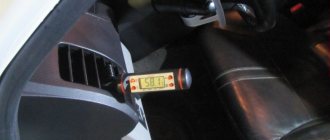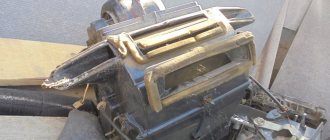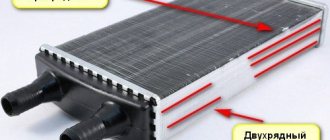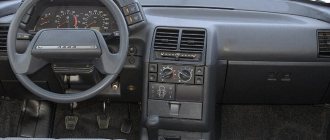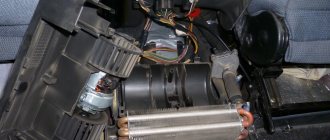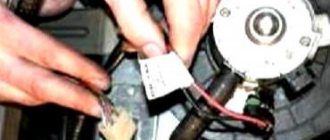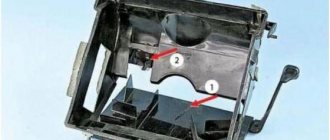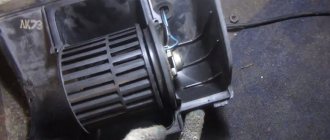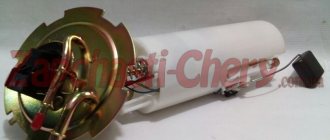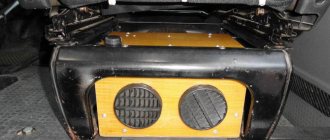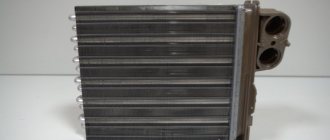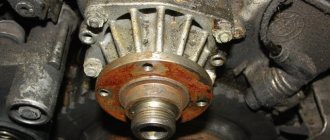Interesting article, I recommend it. I warn you in advance about the presence of many letters
Stove repair in Lanos
Many owners have probably already noticed that the stove on Lanos does not heat well. The reason for this, as a rule, is the heating design, which is designed for a milder climate compared to the Russian one, therefore, even if all components in the system are working properly, you should not hope for special warmth. Moreover, in comparison with the Zhiguli radiator, the dimensions of which are 225x285 with a thickness of 85, here it has dimensions of 220x228 with a thickness of 28 millimeters. Even if it occurs to someone to replace the standard radiator with a more powerful one, nothing will come of it, since another “thicker” radiator simply will not fit here. Of course, you can try, but to do this you will need to remove the panel and ventilation duct. And here you cannot do without depressurizing the air conditioning system. Then it will still be necessary to rework the internal structure of the stove boxes. In general, you will have to do almost everything again.
So, the reasons why the Lanos stove does not heat well. Perhaps they are not all on this list, because it is based mainly on the personal experience of car owners:
1. An internal blockage of the heater radiator has occurred. If such a malfunction occurs, the hoses in the stove begin to produce a completely different temperature. The thermostat starts to open quite often and the same thing happens when the radiator fan turns on.
The cause of such deposits is poor quality antifreeze. Many owners attempt to wash these deposits with a solution of phosphoric acid, descaling agents, Coca-Cola, and so on. Sometimes brushing helps, sometimes it doesn't. At home, you can flush the stove radiator using three pieces of hose of the required size and a solution of citric acid heated on the stove. You can also check at home how much antifreeze parameters affect cooling. Liquid is poured into two containers of up to 50 milliliters, then soda (a pinch) is poured into one container, and any acid (a few drops) into the other. There is no need to worry about the cleanliness of the cooling system if no reaction occurs in both containers.
2. The heater radiator is clogged from the outside. This malfunction is accompanied by the same temperature of the stove hoses and a reduced air flow that exits through the diffusers. Moreover, this blockage does not occur overnight, but over time, and often the decrease in air flow is not noticeable, so the malfunction is better checked when compared with another machine. This car does not have a cabin filter installed, so the heater radiator and air conditioner evaporator can easily become clogged with various leaves, fluff, and so on. This blockage prevents air from passing through the radiator. Also, over time, the air conditioner may develop a putrid odor if there is no filter. This is caused by dust that settles on the evaporator, thereby creating a comfortable habitat for putrefactive bacteria to multiply. Passengers sitting in the car not only smell an unpleasant odor, but also rot spores enter their lungs. Large debris can be easily collected with a vacuum cleaner. To do this, you need to remove the fan and insert a hose into the box, on which you do not need to place any attachments. This procedure can be alternated with blowing through diffusers.
Heating system elements
- Radiator: warms up the air flow by circulating cooling system fluid inside the heat exchanger.
- Electric drive – supercharger: takes air flow into the car interior. Sometimes it is called an impeller or a motor. The preset regulator allows you to mechanically select the optimal position and number of revolutions.
- Heater damper: air flow regulator, with its help we increase or decrease the air temperature inside the cabin.
- Distribution regulators: adjust the airflow to a specific area or the interior as a whole.
Chevrolet Lanos heater device
Replacing the stove radiator
The heater radiator is the main problem of incorrect operation of the Chevrolet Lanos interior heating system. The easiest way to solve this problem is to replace the radiator. The work is quite complex, labor-intensive and expensive. When replacing a radiator, car service specialists completely disassemble the dashboard in the cabin.
However, the work can be done with your own hands without removing the dashboard. To do this, you will need an inspection hole or overpass and the following tools:
- a set of wrenches and sockets;
- Phillips and slotted screwdrivers;
- stationery knife;
- glue "Moment";
- platypuses.
To replace the radiator you will need a standard set of plumbing tools
The design and fastening of the stove body does not depend on the presence of air conditioning in the car. Therefore, for all Chevrolet Lanos models, the procedure for replacing the heater radiator is the same.
- The car is driven into a viewing hole (the best option).
- The front seats are removed. To do this, 4 bolts are unscrewed under each of them.
- The seat belt sensor is disconnected under the driver's seat.
- Three self-tapping screws are unscrewed and the plastic gearbox cover is removed.
- Two self-tapping screws are unscrewed and the handbrake housing is removed.
When replacing the heater radiator, the front seats, plastic covers of the manual transmission and hand brake are removed
To remove the gearbox control rod from the inspection hole, it is necessary to remove the clamp
To remove the manual transmission control mechanism, remove the condensate drain pipe
The gearbox control mechanism can only be removed from the passenger compartment
The sidewalls connecting the center panel casing to the body are removed, and the casing itself is released.
The lower part of the distributor, which directs air flow to the leg area, is secured with three self-tapping screws
To remove the lower part of the stove housing covering the radiator, eight screws are unscrewed
To remove the heater radiator, you need to disconnect the bracket and latch
If the damper does not completely block the flow of cold air, a sealant is glued to it
Installing a new or flushed heater radiator is done in the reverse order.
The radiator can be replaced in another way. To do this, you will need to remove and remove the dashboard from the interior. This operation can be performed on your own in half an hour, without removing the front seats. The dashboard is removed from the passenger compartment along with the stove body, providing access to the elements of the passenger compartment heating system.
Video: replacing the heater radiator with dismantling the dashboard
Choosing a new heater radiator for Chevrolet Lanos
For Chevrolet Lanos, a heater radiator from the Chevrolet Sens model, which has the same dimensions, is suitable. Heat exchangers can be purchased with a strip or plate cooling fin system. In addition, on the market you can find prefabricated strip-plate and tubular-strip brazed aluminum radiators from such manufacturers as NISSENS, AVA, NRF, DAC, GROG, KMC with the number of main tubes from 16 to 22. The cost of products can vary greatly depending on design, workmanship and manufacturer.
Thus, it is quite simple to repair and replace the heater radiator of a Chevrolet Lanos car, consistently following the instructions of professionals. All you need is free time and a standard set of plumbing tools.
Causes of poor heating
Chevrolet Lanos car owners sometimes encounter the fact that the heater blows cold air. The reasons for this “behavior” are different. To correctly identify, you will need experience in servicing the equipment. Otherwise, you risk causing harm with unprofessional intervention. Visit a service station for preventative measures.
Common reasons:
- the critical fuse has blown: the electric motor does not start, no current flows;
- air lock in the system: an obstacle is created to the natural circulation of antifreeze through the channels. The heat exchanger does not receive the required temperature, the air flow does not warm up, so the Lanos stove heats poorly;
- breakage of the standard radiator fasteners: the cause is either mechanical damage, an accident, a collision, or a natural factor. Lanos models produced after 2000 are “endowed” with a similar defect. The radiator moves to the side, the main flow passes by the honeycomb, so the stove does not heat well. Prompt repair of the Lanos stove and cooling system radiator is required;
- clogged antifreeze supply channels: the word “garbage” should not be taken naturally. In relation to cars, we are talking about sediment, the presence of third-party impurities in the composition of the liquid. Poor manufacturing or natural aging leads to the formation of subsidence and cloudiness. A large amount of “garbage” contributes to the formation of clots that block the antifreeze supply and circulation channels;
- mechanical cable break: the last, but most common malfunction due to which the stove does not work. The disadvantage of the design of the Chevrolet Lanos heating system is the absence of an autonomous tap that would shut off the centralized supply of coolant to the heater. Systematic contact with hot antifreeze leaves a negative imprint on the service life. Due to the formation of fossils, the cable's travel is limited and it breaks under force.
Video: Why the Lanos stove does not heat, Sens
In what modes do heating and air conditioning systems operate?
Combinations of switches and sliders on the control panel allow you to set one of its operating modes:
- Maximum cooling. The use of this position is recommended at elevated air temperatures in the summer or when the car is left idle for a long time under the rays of the scorching sun.
- Normal cooling. It is turned on mainly in warm weather, during long trips, since this mode helps maintain a moderate temperature inside.
- Ventilation. It is mainly turned on to ventilate the interior. It is used extremely rarely as a full-fledged mode, which is why most car owners completely ignore this system function.
- Maximum heating. Its use is preferable in conditions of low temperatures in winter, as well as for accelerated heating after a long period of time the vehicle has been at sub-zero temperatures.
- Normal heating. Thanks to the choice of this mode, regardless of the sub-zero air temperature outside the car, the warm-up value set by the driver is always maintained inside it, which allows you to get maximum comfort when moving in a car in winter.
- Window blowing. Allows you to quickly get rid of fogging of side windows and windshields in vehicles. Can be used as a mode for heating or cooling the air in the cabin.
As you can see, the design of the Lanos stove is not particularly complicated and is in many ways similar to the design of the heater of most models of the automotive industry, and this greatly facilitates the diagnosis and elimination of its malfunctions.
How to solve the problem of poor heating
If the Chevrolet Lanos stove does not heat up, then you can eliminate the defect in two ways: by contacting a workshop or by yourself modifying the Lanos stove yourself. Each owner chooses stove repair methods based on financial capabilities and availability of free time.
Troubleshooting algorithm
- The car is in transport position, open the hood and check the level of antifreeze in the cooling system. If necessary, add to the o.
- We start the engine, activate the heater lever, check the uniformity of heat flow through the channels (hoses).
- We start from the upper radiator supply circuit and gradually move into the interior. If the hoses are uniformly warm and there are no cold sections, then the heater radiator is clogged and needs to be cleaned. You can dismantle the radiator without disassembling the torpedo. We remove the gearbox rocker and the central tunnel. We wash the product and install it in the reverse order.
- If the motor does not start: check the integrity of the fuse in the block. Replacing it with a new one will not be a problem. Exceeding the permissible current contributed to burnout.
- The worst option is a break in the heater damper cable: there is nothing to recommend other than complete dismantling and disassembly.
Types of devices for Lanos
Before you get acquainted with all the elements on the Lanos tidy, it must be said that the devices in question are of two types - with a tachometer and without a tachometer. The first Lanos, which were produced under the Daewoo brand, were equipped only with instruments without a tachometer. Later, Lanos began to appear under the Chevrolet brand, and they also had a regular dashboard without a tachometer. A little later, Lanos models appeared, which were already supplied with a new PP dashboard and tachometer.
The dashboards on Lanos cars are produced by two factories - Poland and Korea. How do dashboards differ from each other? First of all, they differ in the design of the pointers. In Polish the signs are round, and in Korean they are square.
- Polish dashboard for Lanos
- can have a scale on the speedometer up to 200 (rare) up to 220 km/h. The Polish one has a bulge on the back of the printed circuit board. This bulge is located in the middle, where the speedometer is located. The Polish tidy with a tachometer has a low beam indicator and a separate hazard warning light from the turn signals. If you are replacing a panel without a tachometer with a tidy with a tachometer, then in order to avoid difficulties, it is recommended to buy a device of this class=”aligncenter” width=”900″ height=”675″[/img] - Korean dashboard for Lanos
— differs from the Polish one in that it has a scale on the speedometer only up to 220 km/h. There is no bulge on the printed circuit board, and there is also no indication of the operation of the low beam headlights and a separate alarm system. If a Chevrolet Lanos has a panel without a tachometer, then when replacing it is recommended to use a Korean device with a tachometer
Chevrolet Lanos heater does not heat: reasons
The simplest reason why the Chevrolet Lanos heater does not heat well is the failure of the fan due to a blown fuse. In the same way, the electric motor switch can fail. All that needs to be done in this case is to change the fuse responsible for the electric motor or fan. They cost pennies, but they change on their own within three minutes.
Another common reason why the stove on a Chevrolet Lanos does not heat well is airing in the cooling system. As a result, antifreeze does not circulate well through the system, and the heat exchanger does not heat up enough. In order to understand the reason for this or not, you need to touch the hoses at the inlet and outlet of the heating system. This whole thing is located under the hood, in the engine compartment. If both tubes are cold, you need to fix the problem. This is done extremely simply. It is enough to open the cap of the expansion tank, then make the car stand at an angle (on some incline, with the front facing up) and hold the engine at medium speed (in neutral gear) for a couple of minutes. As a result, all the air that was in the system will escape through the open expansion tank.
Answers to frequently asked questions
- What to do if warm air reaches only the front passengers? Answer: Most likely, there is a blockage in the dashboard or the fan itself is clogged.
- How can I make the heater blow harder? Answer: there is no need to hide the truth, in Chance the stove is not the best aspect of this car. However, there is an easy way to achieve better performance - you need to place a piece of cardboard between the radiator and the grille.
- The windshield sweats too much, what should I do? It is possible that snow has clogged the air intake grilles installed near the windshield. And also see if the damper in your car is switched from Auto ZAZ to air intake.
The Chevrolet Lanos stove still does not heat well. What to do?
If the tips described above did not help you, there is a possibility that the reason that the Chevrolet Lanos heater stopped heating could be a displacement of the radiator. In cars manufactured since 2004, the heater radiator mounting clamps often break. As a result, it warps a little, and the bulk of the warm air simply passes by it.
Chevrolet Lanos heater radiator
The second more complex breakdown is a clogged radiator. This occurs in older cars in which this radiator has never been replaced. There is only one way out - replacing the radiator.
The Chevrolet Lanos stove does not heat well video:
Stove ZAZ Chance
According to owners of Ukrainian-made cars, at the beginning of using the car, the ZAZ Chance heater heats more or less well, but over time quite often (car mechanics claim that in almost 8 out of 10 cases!) the heater mount comes off, or rather the latch bracket that presses the radiator stoves to the air duct. And therefore, in the resulting gaps, bypassing the radiator, the heater blows poorly into the interior of the ZAZ Chance or only cold air enters, thereby reducing the efficiency of the entire heating system by up to 90%.
In addition, the reasons why the ZAZ Chance stove does not work may be:
- if the tubes inside the radiator are clogged;
- if the outer plates of the heater radiator are clogged;
- when the thermostat does not close completely or its normal operation is disrupted.
These reasons are easily diagnosed and, as an example, when the tubes inside the radiator are clogged, the incoming radiator pipe will be hot, and the outgoing pipe will be either completely cold or barely warm.
If the outer radiator plates are clogged, the temperature of the inlet and outlet pipes will be approximately the same. And if the normal operation of the thermostat is disrupted, then this can be determined by the readings of the antifreeze temperature device, when even after prolonged warming up of the engine, the thermometer needle does not move for a long time.
To determine whether the heater radiator latch bracket is broken, you need to shake the pipes that go to the radiator from the side of the engine compartment. The movement of the pipes in the place where the heater radiator of the ZAZ Chance is located will mean that it is not secured or, as motorists say, “the heater radiator has fallen.”
Of the four cases of poor heater performance considered, in three it is necessary to get to the heater radiator or even remove it. Of course, you can entrust the elimination of the reasons for the poor operation of the stove to a car service, but, firstly, replacing the radiator of the ZAZ Chance stove in a car repair shop, as they say, “will cost a pretty penny,” and secondly, many car enthusiasts like to fix certain malfunctions of their “iron friend” themselves "
How to make SENS,LANOS warm, Refinishing the stove. 1 of the options
I’ll start from afar and get sick of freezing in winter.
and washed and disassembled for the presence of a loose radiator. someone will say that the stove heats well compared to the refrigerator, yes. Here in Slavuta the stove heats up despite a bunch of holes in the cabin, and in 9 it heats up there with some kind of low or high panel, I don’t remember. 1. We buy a stove radiator from 8 COPPER BRASS or anything that looks like a radiator and cut it 9.5 cm wide just under the nearest vertical channel. price 1400 rub.
2. We solder the partitions, having previously cut out textolite or copper patches.
3. if you put the radiator lying down and the pipes are looking at you from the right side, then in this position we saw off the bottom pipe 1 cm (as soon as the protrusion ends, saw it off) and solder 2 mm copper wire to it in a circle creating a protrusion for tightness. (I forgot to take a photo). This is necessary for him to fit where he needs to. If you manage to cram it in like that, well done.
4. We weld such a structure from a metal rod with thread or look for mounting wire.
5. Cut the tubes according to size and fasten the clamps. faucet taken from SLAVUTA from the stove total about 500 rubles. or it can be similar from the cooling system. a good one from Moskvich is a little smaller and metallic.
6. Drill holes in the body. DO NOT PAY ATTENTION TO THE FACT THAT IN THE PHOTO THE RADIATOR BECAME ALUMINUM. A BAD EXPERIENCE and decided to change everything to copper-brass.
7. We push the radiator into its original place and fasten it with mounting wire or put on the device in the figure in point 4.
8. We put on the clamps by cutting the hoses from the stove and onto the radiator.
9. We foam the radiator with polyurethane foam or invent our own sealant. The radiator stays rooted to the spot on the foam. You can remove the wire or you can leave it, I left it in case the foam becomes loose over the years, there is something to tighten it up.
You can come up with a clever paralon gasket if you want to bother.
10. We shout Hurray and go to wash because... all this is done from 9.00 to 17.00 on Saturday (if all the parts are available) without straining (I did everything impromptu and went for spare parts, everything was adjusted, the dust was in front of my nose. + after water leaked through the tubes that were not secured with clamps and placed on sealant, I had to postpone until the next weeks). and on Sunday he makes us happy with his Sunday.
13. Tests: outside + 15-20 degrees, the assessment is subjective, but still I drove the car into a cold garage and cooled it down; it was night. I have a regular stove for the cold. extra for full heat. When the car is warmed up, turn on the fan. At first, the disappointment barely blows warm. after 2-3 minutes the entire panel (Torpedo) heated up and really warm air came out, while the car itself was hot. as it was before, the floor of the car is cold, especially the front passenger seat in the glove compartment area is like a piece of ice and there is nothing you can do to warm it up. Next, I turned the standard heater on full blast and almost burned my hands. boiling water is REAL. then I turned off the additional stove, blew everything out, turned on the standard one, only hot, almost boiling water. and from this I came to approximately the following conclusion: an additional stove gives an increase of 30% (50% of the standard one if the pipe that goes from the engine to the thermostat is pressed a little). This fact may not be noticeable in the warm season. at -30 the stove gives + 70 result +40 i.e. like a hot water bottle made of urine. and if -30 comes from the street, let the first stove be +50, even already +20, and imagine at +20 degrees how the standard one will heat. + TORPEDO has a positive temperature. and not as in normal mode. Cold air passes through the entire panel and then only warms up at the exit.
I didn’t measure it with a thermometer, necessarily at -30 overboard. but this is in winter and should be done in summer or autumn.
The heat became awesome after installing the brass one. The additional radiator heated twice as hot as the standard one, and together with the standard one it was just a bathhouse. at +10 degrees overboard. I haven’t gotten rid of the 3 by 3 cm drainage hole yet; it also needs to be foamed and a small hole made with a nail.
I'm waiting for your kicks and like BARVORY. and to whom my article will help, I wish you good luck. You can also make any car.
Post edited by LENIN85
— Sep 12 2013, 14:52
